CHCECE002 - Ensure Health and Safety of Children: Short Questions
VerifiedAdded on 2023/01/09
|34
|8359
|100
Homework Assignment
AI Summary
This document presents a completed homework assignment for the CHCECE002 unit, which focuses on ensuring the health and safety of children in early childhood education and care settings. The assignment includes a series of short answer questions, true/false questions, and matching exercises designed to assess the student's understanding of key concepts. These concepts include the National Quality Standard elements related to health, safety, and wellbeing, infectious disease control, cleaning procedures, and emergency management. The assignment also covers topics such as hygiene practices, fire safety protocols, and the appropriate use of personal protective equipment. The student's responses demonstrate an understanding of the regulations and best practices required to create a safe and healthy environment for children, including specific procedures for cleaning and sanitizing equipment and responding to potential hazards. This resource is valuable for students studying childcare and early childhood education, providing a clear example of how to address the key learning outcomes of the CHCECE002 unit.
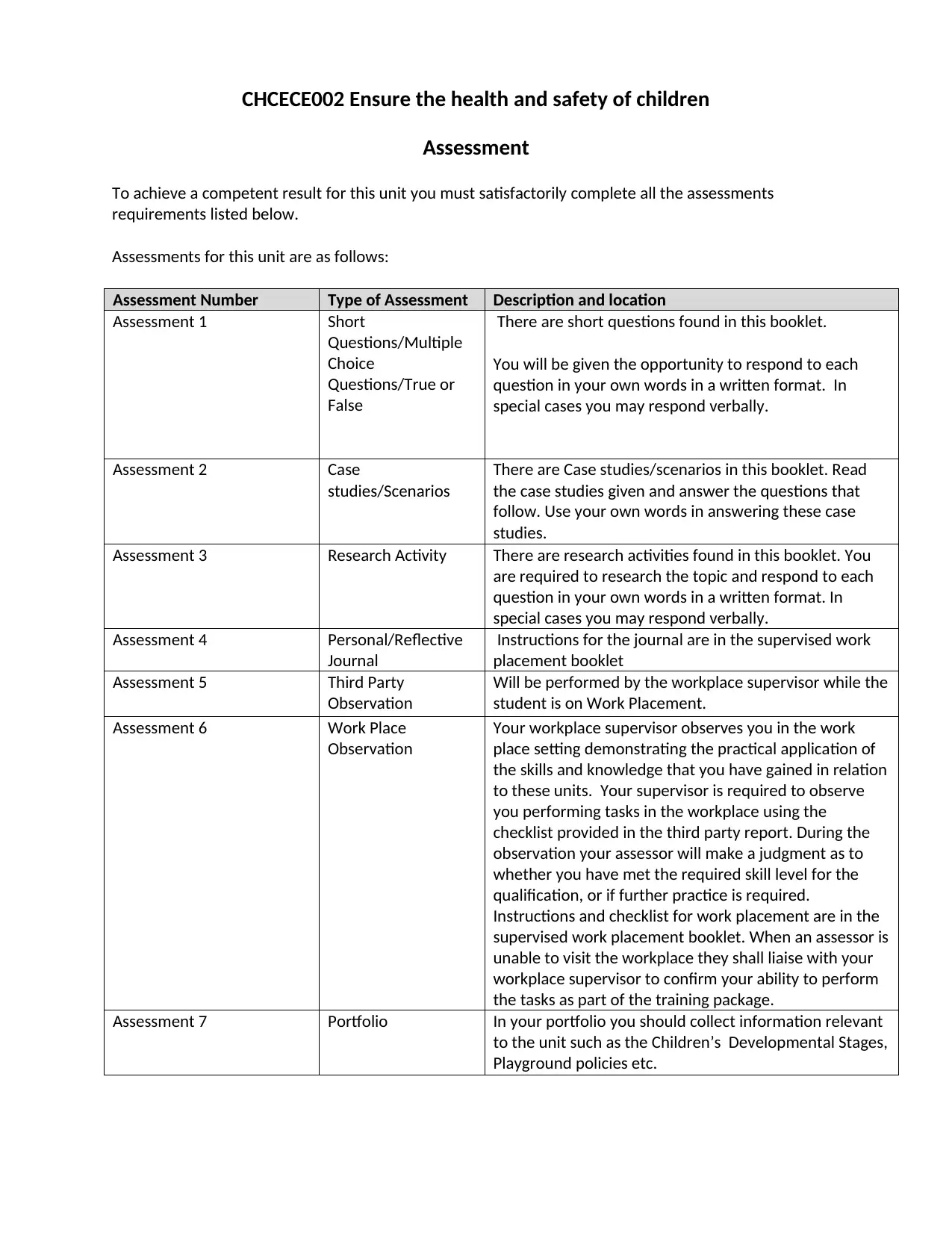
CHCECE002 Ensure the health and safety of children
Assessment
To achieve a competent result for this unit you must satisfactorily complete all the assessments
requirements listed below.
Assessments for this unit are as follows:
Assessment Number Type of Assessment Description and location
Assessment 1 Short
Questions/Multiple
Choice
Questions/True or
False
There are short questions found in this booklet.
You will be given the opportunity to respond to each
question in your own words in a written format. In
special cases you may respond verbally.
Assessment 2 Case
studies/Scenarios
There are Case studies/scenarios in this booklet. Read
the case studies given and answer the questions that
follow. Use your own words in answering these case
studies.
Assessment 3 Research Activity There are research activities found in this booklet. You
are required to research the topic and respond to each
question in your own words in a written format. In
special cases you may respond verbally.
Assessment 4 Personal/Reflective
Journal
Instructions for the journal are in the supervised work
placement booklet
Assessment 5 Third Party
Observation
Will be performed by the workplace supervisor while the
student is on Work Placement.
Assessment 6 Work Place
Observation
Your workplace supervisor observes you in the work
place setting demonstrating the practical application of
the skills and knowledge that you have gained in relation
to these units. Your supervisor is required to observe
you performing tasks in the workplace using the
checklist provided in the third party report. During the
observation your assessor will make a judgment as to
whether you have met the required skill level for the
qualification, or if further practice is required.
Instructions and checklist for work placement are in the
supervised work placement booklet. When an assessor is
unable to visit the workplace they shall liaise with your
workplace supervisor to confirm your ability to perform
the tasks as part of the training package.
Assessment 7 Portfolio In your portfolio you should collect information relevant
to the unit such as the Children’s Developmental Stages,
Playground policies etc.
Assessment
To achieve a competent result for this unit you must satisfactorily complete all the assessments
requirements listed below.
Assessments for this unit are as follows:
Assessment Number Type of Assessment Description and location
Assessment 1 Short
Questions/Multiple
Choice
Questions/True or
False
There are short questions found in this booklet.
You will be given the opportunity to respond to each
question in your own words in a written format. In
special cases you may respond verbally.
Assessment 2 Case
studies/Scenarios
There are Case studies/scenarios in this booklet. Read
the case studies given and answer the questions that
follow. Use your own words in answering these case
studies.
Assessment 3 Research Activity There are research activities found in this booklet. You
are required to research the topic and respond to each
question in your own words in a written format. In
special cases you may respond verbally.
Assessment 4 Personal/Reflective
Journal
Instructions for the journal are in the supervised work
placement booklet
Assessment 5 Third Party
Observation
Will be performed by the workplace supervisor while the
student is on Work Placement.
Assessment 6 Work Place
Observation
Your workplace supervisor observes you in the work
place setting demonstrating the practical application of
the skills and knowledge that you have gained in relation
to these units. Your supervisor is required to observe
you performing tasks in the workplace using the
checklist provided in the third party report. During the
observation your assessor will make a judgment as to
whether you have met the required skill level for the
qualification, or if further practice is required.
Instructions and checklist for work placement are in the
supervised work placement booklet. When an assessor is
unable to visit the workplace they shall liaise with your
workplace supervisor to confirm your ability to perform
the tasks as part of the training package.
Assessment 7 Portfolio In your portfolio you should collect information relevant
to the unit such as the Children’s Developmental Stages,
Playground policies etc.
Paraphrase This Document
Need a fresh take? Get an instant paraphrase of this document with our AI Paraphraser
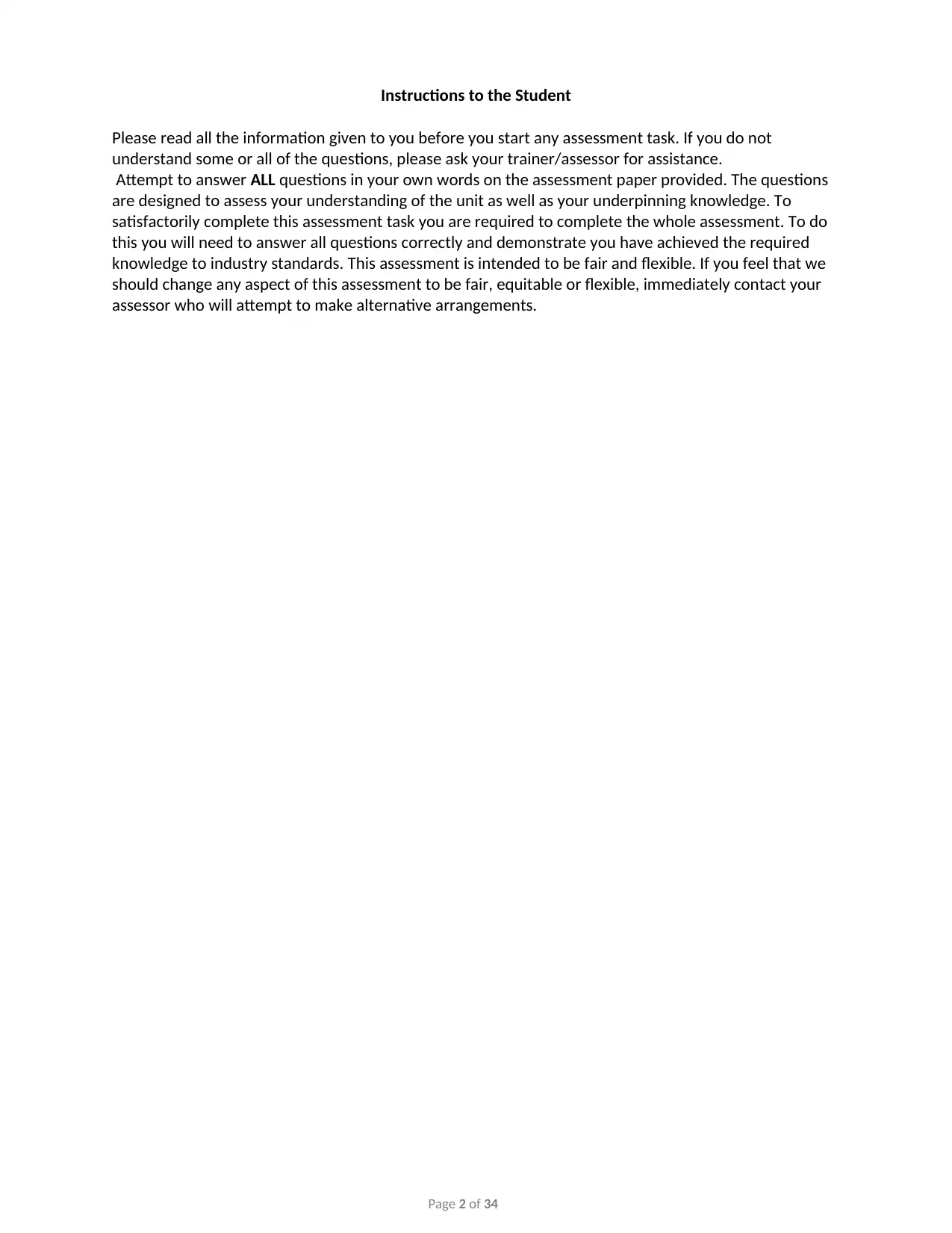
Instructions to the Student
Please read all the information given to you before you start any assessment task. If you do not
understand some or all of the questions, please ask your trainer/assessor for assistance.
Attempt to answer ALL questions in your own words on the assessment paper provided. The questions
are designed to assess your understanding of the unit as well as your underpinning knowledge. To
satisfactorily complete this assessment task you are required to complete the whole assessment. To do
this you will need to answer all questions correctly and demonstrate you have achieved the required
knowledge to industry standards. This assessment is intended to be fair and flexible. If you feel that we
should change any aspect of this assessment to be fair, equitable or flexible, immediately contact your
assessor who will attempt to make alternative arrangements.
Page 2 of 34
Please read all the information given to you before you start any assessment task. If you do not
understand some or all of the questions, please ask your trainer/assessor for assistance.
Attempt to answer ALL questions in your own words on the assessment paper provided. The questions
are designed to assess your understanding of the unit as well as your underpinning knowledge. To
satisfactorily complete this assessment task you are required to complete the whole assessment. To do
this you will need to answer all questions correctly and demonstrate you have achieved the required
knowledge to industry standards. This assessment is intended to be fair and flexible. If you feel that we
should change any aspect of this assessment to be fair, equitable or flexible, immediately contact your
assessor who will attempt to make alternative arrangements.
Page 2 of 34
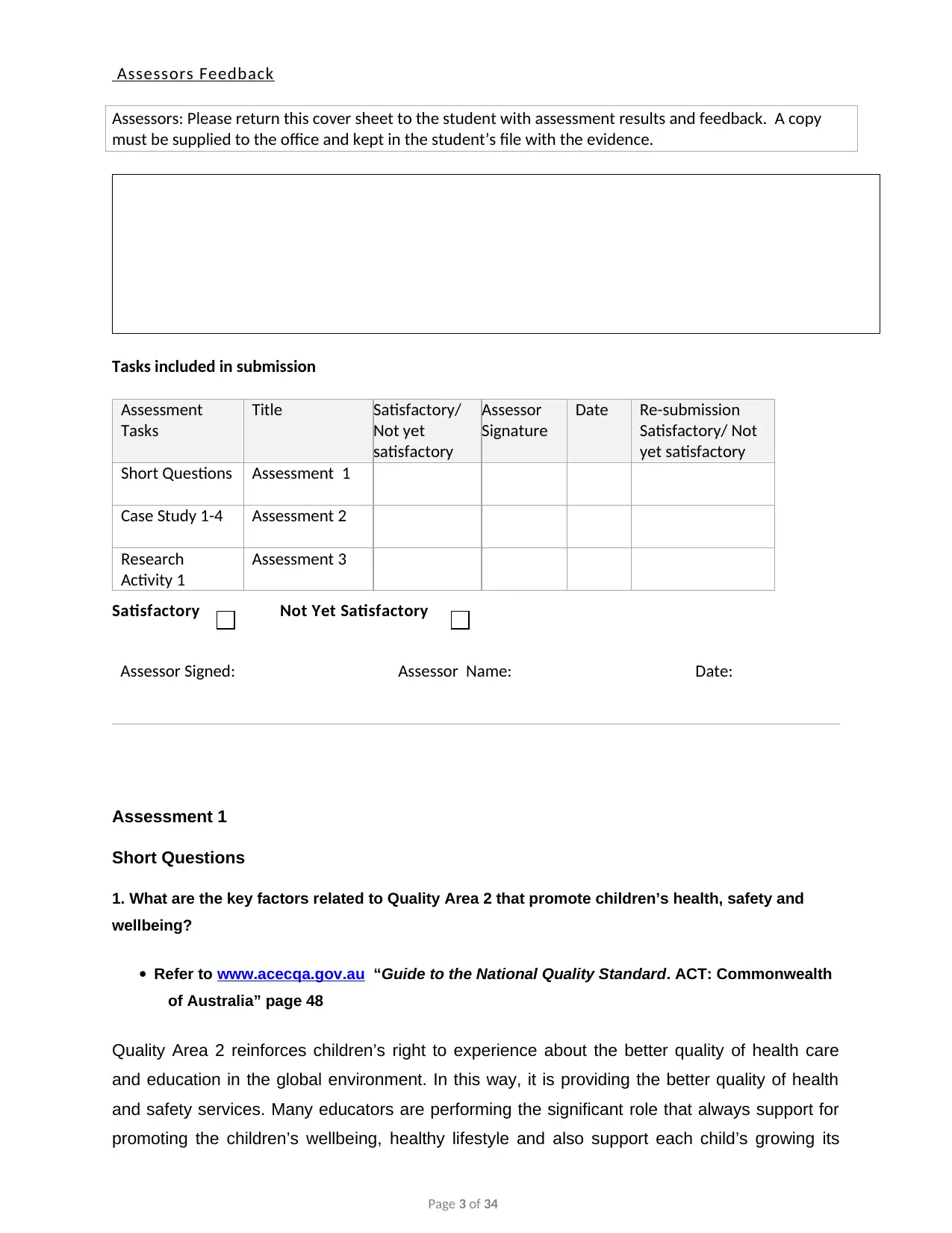
Assessors Feedback
Assessors: Please return this cover sheet to the student with assessment results and feedback. A copy
must be supplied to the office and kept in the student’s file with the evidence.
Tasks included in submission
Assessment
Tasks
Title Satisfactory/
Not yet
satisfactory
Assessor
Signature
Date Re-submission
Satisfactory/ Not
yet satisfactory
Short Questions Assessment 1
Case Study 1-4 Assessment 2
Research
Activity 1
Assessment 3
Satisfactory Not Yet Satisfactory
Assessor Signed: Assessor Name: Date:
Assessment 1
Short Questions
1. What are the key factors related to Quality Area 2 that promote children’s health, safety and
wellbeing?
Refer to www.acecqa.gov.au “Guide to the National Quality Standard. ACT: Commonwealth
of Australia” page 48
Quality Area 2 reinforces children’s right to experience about the better quality of health care
and education in the global environment. In this way, it is providing the better quality of health
and safety services. Many educators are performing the significant role that always support for
promoting the children’s wellbeing, healthy lifestyle and also support each child’s growing its
Page 3 of 34
Assessors: Please return this cover sheet to the student with assessment results and feedback. A copy
must be supplied to the office and kept in the student’s file with the evidence.
Tasks included in submission
Assessment
Tasks
Title Satisfactory/
Not yet
satisfactory
Assessor
Signature
Date Re-submission
Satisfactory/ Not
yet satisfactory
Short Questions Assessment 1
Case Study 1-4 Assessment 2
Research
Activity 1
Assessment 3
Satisfactory Not Yet Satisfactory
Assessor Signed: Assessor Name: Date:
Assessment 1
Short Questions
1. What are the key factors related to Quality Area 2 that promote children’s health, safety and
wellbeing?
Refer to www.acecqa.gov.au “Guide to the National Quality Standard. ACT: Commonwealth
of Australia” page 48
Quality Area 2 reinforces children’s right to experience about the better quality of health care
and education in the global environment. In this way, it is providing the better quality of health
and safety services. Many educators are performing the significant role that always support for
promoting the children’s wellbeing, healthy lifestyle and also support each child’s growing its
Page 3 of 34
⊘ This is a preview!⊘
Do you want full access?
Subscribe today to unlock all pages.

Trusted by 1+ million students worldwide
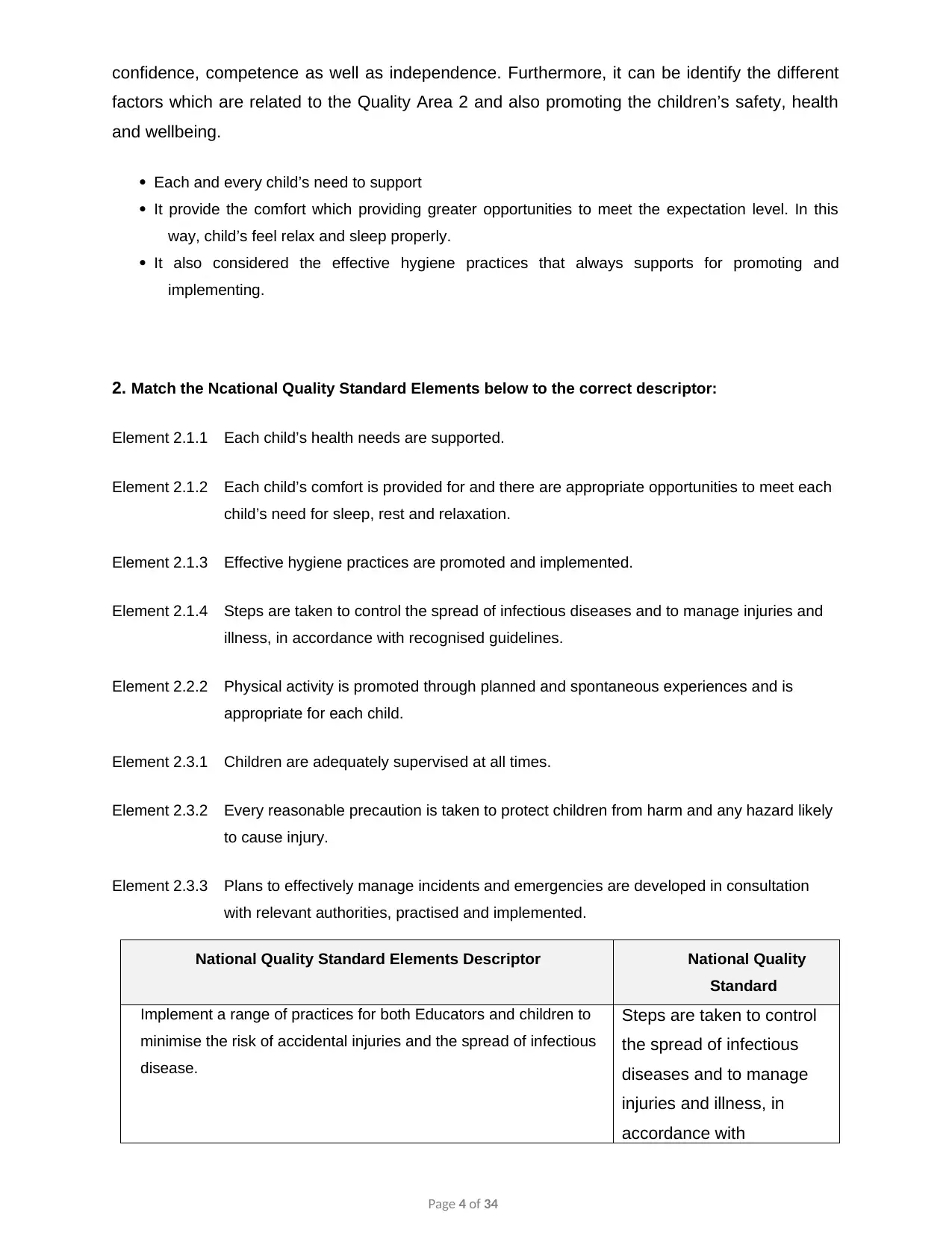
confidence, competence as well as independence. Furthermore, it can be identify the different
factors which are related to the Quality Area 2 and also promoting the children’s safety, health
and wellbeing.
Each and every child’s need to support
It provide the comfort which providing greater opportunities to meet the expectation level. In this
way, child’s feel relax and sleep properly.
It also considered the effective hygiene practices that always supports for promoting and
implementing.
2. Match the Ncational Quality Standard Elements below to the correct descriptor:
Element 2.1.1 Each child’s health needs are supported.
Element 2.1.2 Each child’s comfort is provided for and there are appropriate opportunities to meet each
child’s need for sleep, rest and relaxation.
Element 2.1.3 Effective hygiene practices are promoted and implemented.
Element 2.1.4 Steps are taken to control the spread of infectious diseases and to manage injuries and
illness, in accordance with recognised guidelines.
Element 2.2.2 Physical activity is promoted through planned and spontaneous experiences and is
appropriate for each child.
Element 2.3.1 Children are adequately supervised at all times.
Element 2.3.2 Every reasonable precaution is taken to protect children from harm and any hazard likely
to cause injury.
Element 2.3.3 Plans to effectively manage incidents and emergencies are developed in consultation
with relevant authorities, practised and implemented.
National Quality Standard Elements Descriptor National Quality
Standard
Implement a range of practices for both Educators and children to
minimise the risk of accidental injuries and the spread of infectious
disease.
Steps are taken to control
the spread of infectious
diseases and to manage
injuries and illness, in
accordance with
Page 4 of 34
factors which are related to the Quality Area 2 and also promoting the children’s safety, health
and wellbeing.
Each and every child’s need to support
It provide the comfort which providing greater opportunities to meet the expectation level. In this
way, child’s feel relax and sleep properly.
It also considered the effective hygiene practices that always supports for promoting and
implementing.
2. Match the Ncational Quality Standard Elements below to the correct descriptor:
Element 2.1.1 Each child’s health needs are supported.
Element 2.1.2 Each child’s comfort is provided for and there are appropriate opportunities to meet each
child’s need for sleep, rest and relaxation.
Element 2.1.3 Effective hygiene practices are promoted and implemented.
Element 2.1.4 Steps are taken to control the spread of infectious diseases and to manage injuries and
illness, in accordance with recognised guidelines.
Element 2.2.2 Physical activity is promoted through planned and spontaneous experiences and is
appropriate for each child.
Element 2.3.1 Children are adequately supervised at all times.
Element 2.3.2 Every reasonable precaution is taken to protect children from harm and any hazard likely
to cause injury.
Element 2.3.3 Plans to effectively manage incidents and emergencies are developed in consultation
with relevant authorities, practised and implemented.
National Quality Standard Elements Descriptor National Quality
Standard
Implement a range of practices for both Educators and children to
minimise the risk of accidental injuries and the spread of infectious
disease.
Steps are taken to control
the spread of infectious
diseases and to manage
injuries and illness, in
accordance with
Page 4 of 34
Paraphrase This Document
Need a fresh take? Get an instant paraphrase of this document with our AI Paraphraser
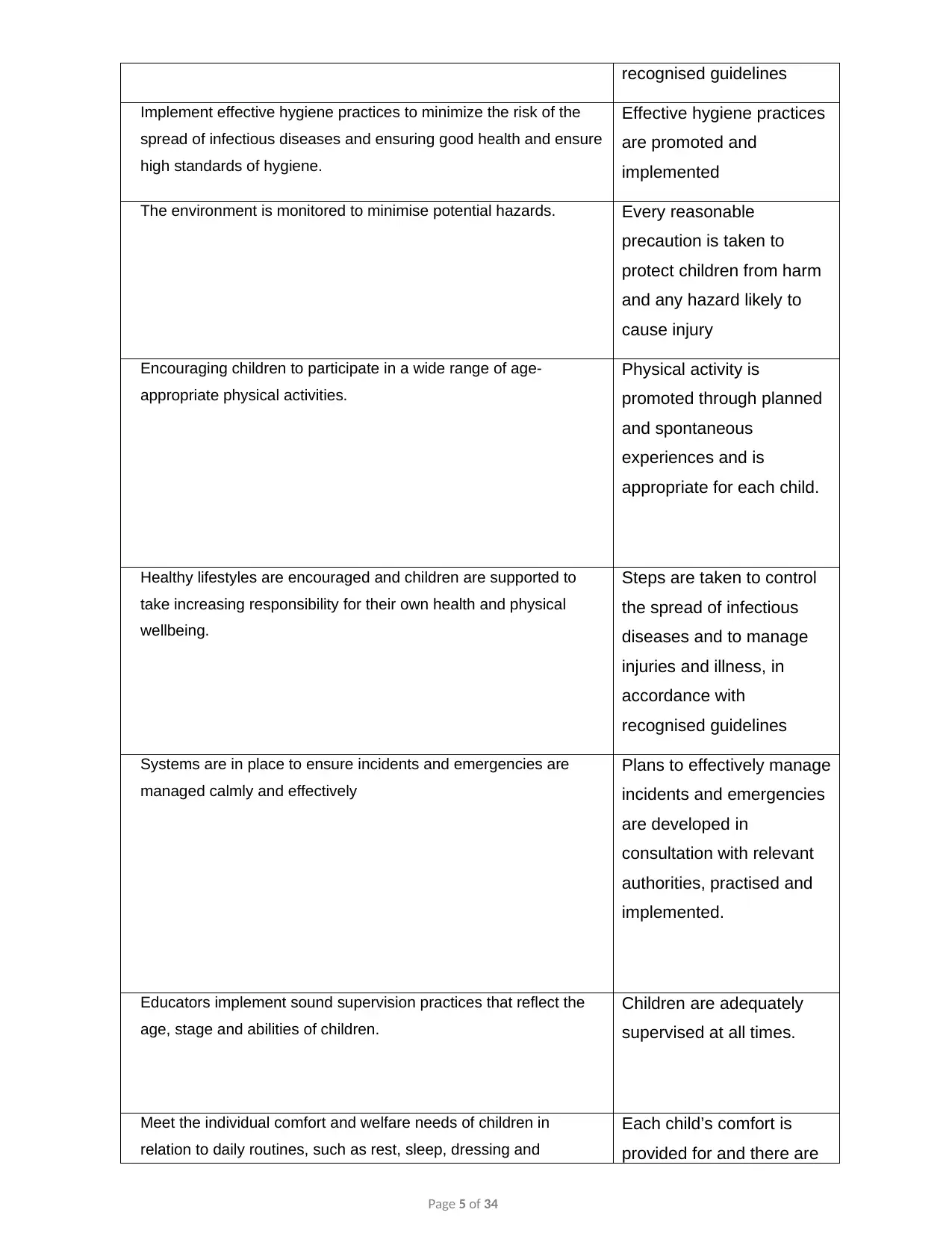
recognised guidelines
Implement effective hygiene practices to minimize the risk of the
spread of infectious diseases and ensuring good health and ensure
high standards of hygiene.
Effective hygiene practices
are promoted and
implemented
The environment is monitored to minimise potential hazards. Every reasonable
precaution is taken to
protect children from harm
and any hazard likely to
cause injury
Encouraging children to participate in a wide range of age-
appropriate physical activities.
Physical activity is
promoted through planned
and spontaneous
experiences and is
appropriate for each child.
Healthy lifestyles are encouraged and children are supported to
take increasing responsibility for their own health and physical
wellbeing.
Steps are taken to control
the spread of infectious
diseases and to manage
injuries and illness, in
accordance with
recognised guidelines
Systems are in place to ensure incidents and emergencies are
managed calmly and effectively
Plans to effectively manage
incidents and emergencies
are developed in
consultation with relevant
authorities, practised and
implemented.
Educators implement sound supervision practices that reflect the
age, stage and abilities of children.
Children are adequately
supervised at all times.
Meet the individual comfort and welfare needs of children in
relation to daily routines, such as rest, sleep, dressing and
Each child’s comfort is
provided for and there are
Page 5 of 34
Implement effective hygiene practices to minimize the risk of the
spread of infectious diseases and ensuring good health and ensure
high standards of hygiene.
Effective hygiene practices
are promoted and
implemented
The environment is monitored to minimise potential hazards. Every reasonable
precaution is taken to
protect children from harm
and any hazard likely to
cause injury
Encouraging children to participate in a wide range of age-
appropriate physical activities.
Physical activity is
promoted through planned
and spontaneous
experiences and is
appropriate for each child.
Healthy lifestyles are encouraged and children are supported to
take increasing responsibility for their own health and physical
wellbeing.
Steps are taken to control
the spread of infectious
diseases and to manage
injuries and illness, in
accordance with
recognised guidelines
Systems are in place to ensure incidents and emergencies are
managed calmly and effectively
Plans to effectively manage
incidents and emergencies
are developed in
consultation with relevant
authorities, practised and
implemented.
Educators implement sound supervision practices that reflect the
age, stage and abilities of children.
Children are adequately
supervised at all times.
Meet the individual comfort and welfare needs of children in
relation to daily routines, such as rest, sleep, dressing and
Each child’s comfort is
provided for and there are
Page 5 of 34
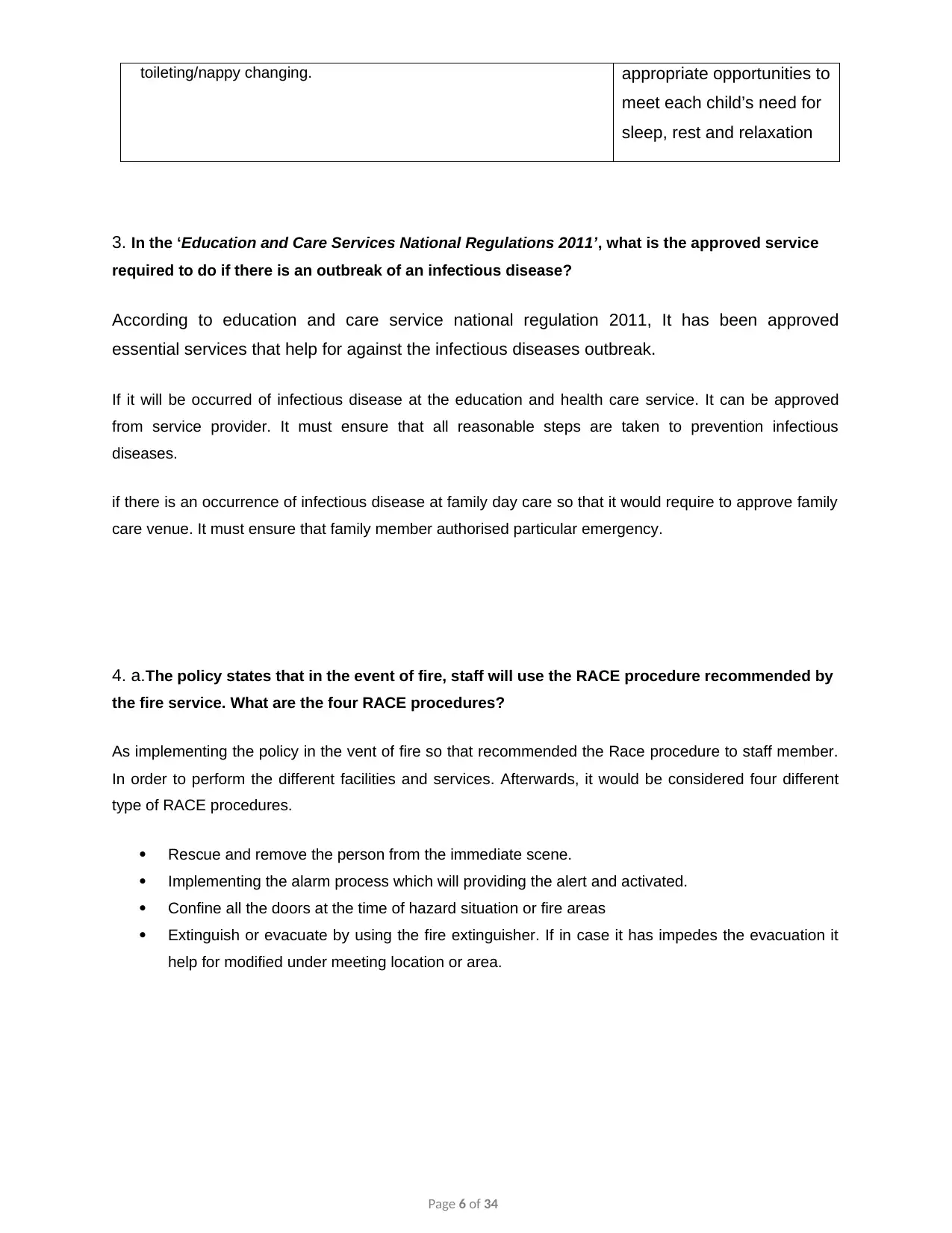
toileting/nappy changing. appropriate opportunities to
meet each child’s need for
sleep, rest and relaxation
3. In the ‘Education and Care Services National Regulations 2011’, what is the approved service
required to do if there is an outbreak of an infectious disease?
According to education and care service national regulation 2011, It has been approved
essential services that help for against the infectious diseases outbreak.
If it will be occurred of infectious disease at the education and health care service. It can be approved
from service provider. It must ensure that all reasonable steps are taken to prevention infectious
diseases.
if there is an occurrence of infectious disease at family day care so that it would require to approve family
care venue. It must ensure that family member authorised particular emergency.
4. a.The policy states that in the event of fire, staff will use the RACE procedure recommended by
the fire service. What are the four RACE procedures?
As implementing the policy in the vent of fire so that recommended the Race procedure to staff member.
In order to perform the different facilities and services. Afterwards, it would be considered four different
type of RACE procedures.
Rescue and remove the person from the immediate scene.
Implementing the alarm process which will providing the alert and activated.
Confine all the doors at the time of hazard situation or fire areas
Extinguish or evacuate by using the fire extinguisher. If in case it has impedes the evacuation it
help for modified under meeting location or area.
Page 6 of 34
meet each child’s need for
sleep, rest and relaxation
3. In the ‘Education and Care Services National Regulations 2011’, what is the approved service
required to do if there is an outbreak of an infectious disease?
According to education and care service national regulation 2011, It has been approved
essential services that help for against the infectious diseases outbreak.
If it will be occurred of infectious disease at the education and health care service. It can be approved
from service provider. It must ensure that all reasonable steps are taken to prevention infectious
diseases.
if there is an occurrence of infectious disease at family day care so that it would require to approve family
care venue. It must ensure that family member authorised particular emergency.
4. a.The policy states that in the event of fire, staff will use the RACE procedure recommended by
the fire service. What are the four RACE procedures?
As implementing the policy in the vent of fire so that recommended the Race procedure to staff member.
In order to perform the different facilities and services. Afterwards, it would be considered four different
type of RACE procedures.
Rescue and remove the person from the immediate scene.
Implementing the alarm process which will providing the alert and activated.
Confine all the doors at the time of hazard situation or fire areas
Extinguish or evacuate by using the fire extinguisher. If in case it has impedes the evacuation it
help for modified under meeting location or area.
Page 6 of 34
⊘ This is a preview!⊘
Do you want full access?
Subscribe today to unlock all pages.

Trusted by 1+ million students worldwide
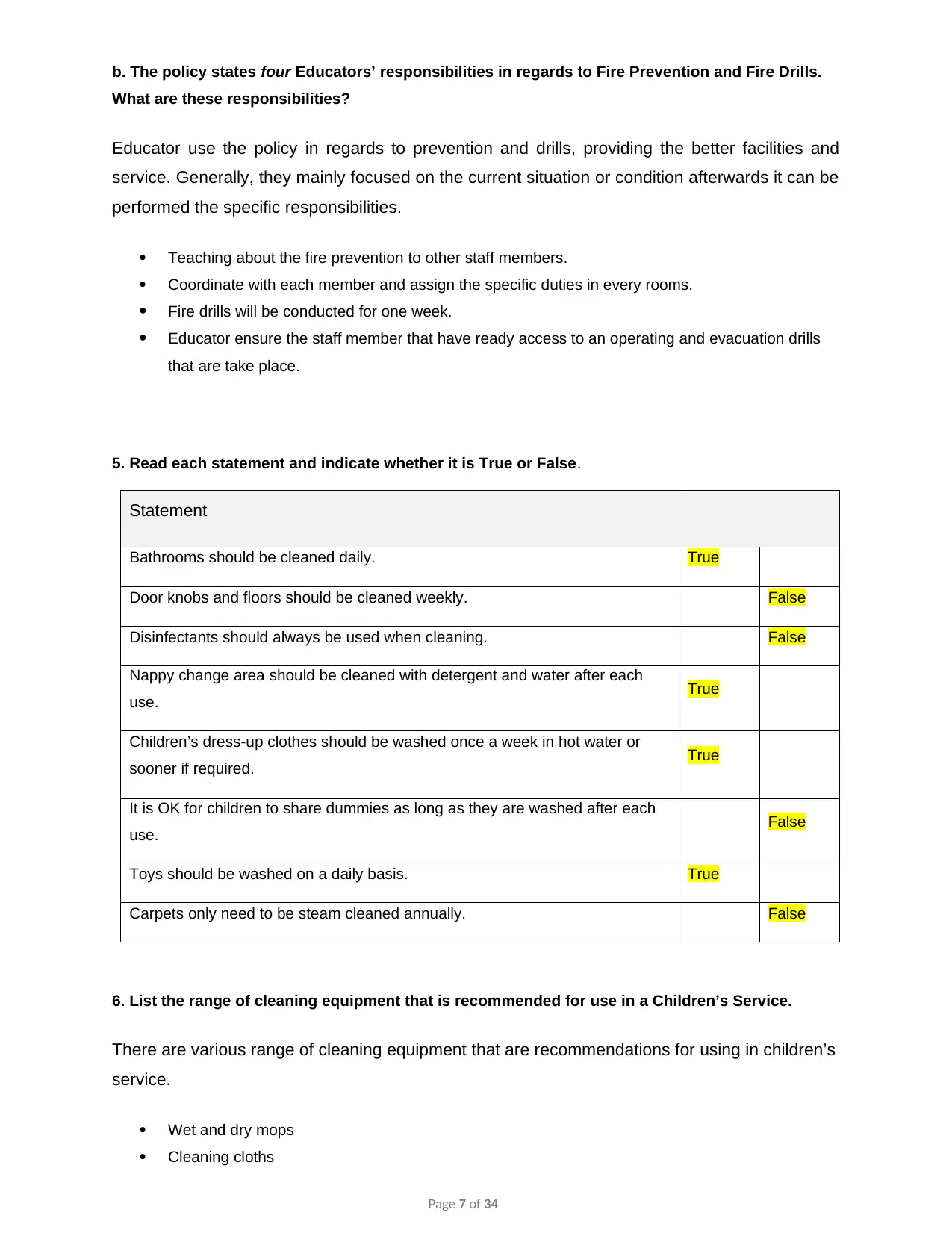
b. The policy states four Educators’ responsibilities in regards to Fire Prevention and Fire Drills.
What are these responsibilities?
Educator use the policy in regards to prevention and drills, providing the better facilities and
service. Generally, they mainly focused on the current situation or condition afterwards it can be
performed the specific responsibilities.
Teaching about the fire prevention to other staff members.
Coordinate with each member and assign the specific duties in every rooms.
Fire drills will be conducted for one week.
Educator ensure the staff member that have ready access to an operating and evacuation drills
that are take place.
5. Read each statement and indicate whether it is True or False.
Statement
Bathrooms should be cleaned daily. True
Door knobs and floors should be cleaned weekly. False
Disinfectants should always be used when cleaning. False
Nappy change area should be cleaned with detergent and water after each
use. True
Children’s dress-up clothes should be washed once a week in hot water or
sooner if required. True
It is OK for children to share dummies as long as they are washed after each
use. False
Toys should be washed on a daily basis. True
Carpets only need to be steam cleaned annually. False
6. List the range of cleaning equipment that is recommended for use in a Children’s Service.
There are various range of cleaning equipment that are recommendations for using in children’s
service.
Wet and dry mops
Cleaning cloths
Page 7 of 34
What are these responsibilities?
Educator use the policy in regards to prevention and drills, providing the better facilities and
service. Generally, they mainly focused on the current situation or condition afterwards it can be
performed the specific responsibilities.
Teaching about the fire prevention to other staff members.
Coordinate with each member and assign the specific duties in every rooms.
Fire drills will be conducted for one week.
Educator ensure the staff member that have ready access to an operating and evacuation drills
that are take place.
5. Read each statement and indicate whether it is True or False.
Statement
Bathrooms should be cleaned daily. True
Door knobs and floors should be cleaned weekly. False
Disinfectants should always be used when cleaning. False
Nappy change area should be cleaned with detergent and water after each
use. True
Children’s dress-up clothes should be washed once a week in hot water or
sooner if required. True
It is OK for children to share dummies as long as they are washed after each
use. False
Toys should be washed on a daily basis. True
Carpets only need to be steam cleaned annually. False
6. List the range of cleaning equipment that is recommended for use in a Children’s Service.
There are various range of cleaning equipment that are recommendations for using in children’s
service.
Wet and dry mops
Cleaning cloths
Page 7 of 34
Paraphrase This Document
Need a fresh take? Get an instant paraphrase of this document with our AI Paraphraser
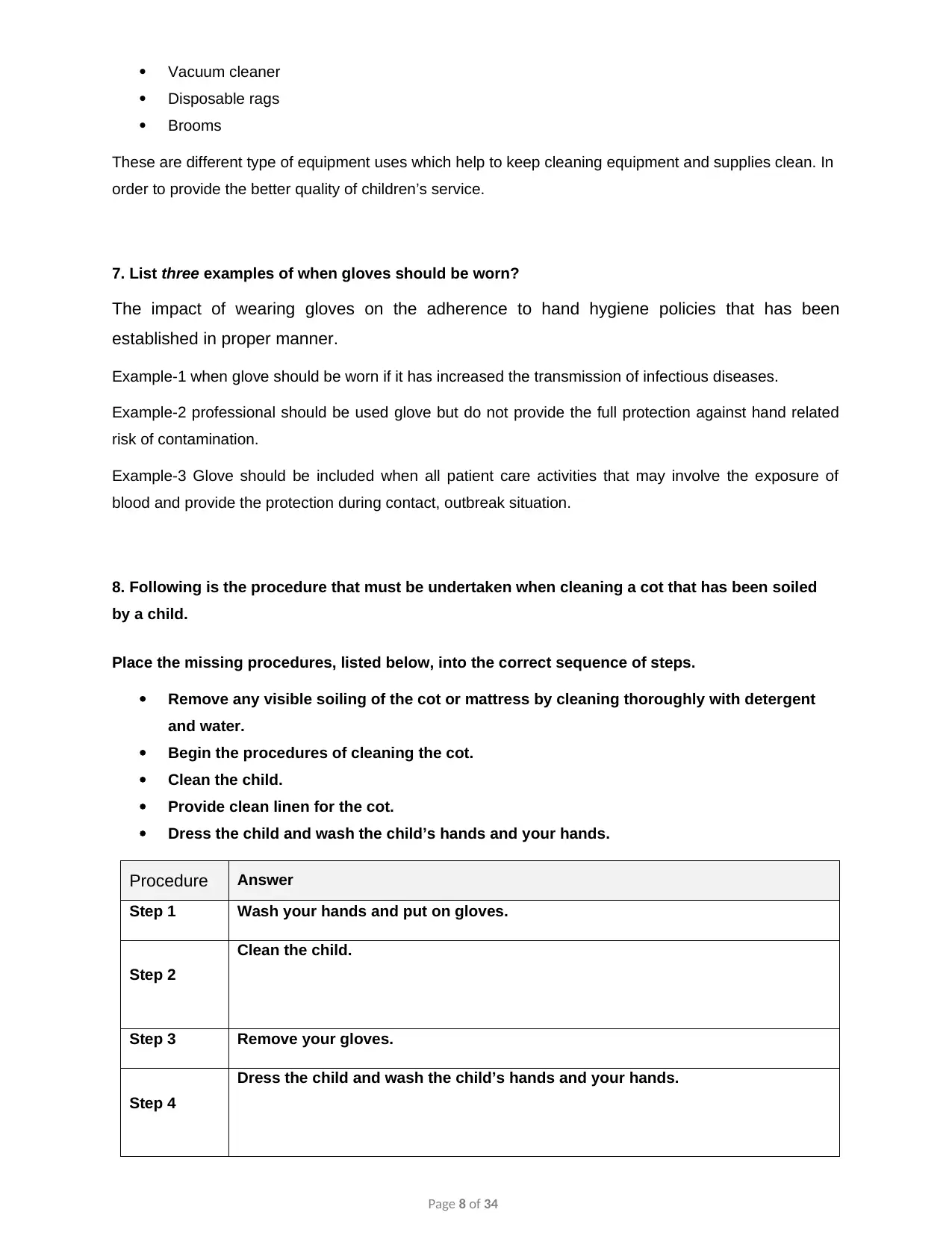
Vacuum cleaner
Disposable rags
Brooms
These are different type of equipment uses which help to keep cleaning equipment and supplies clean. In
order to provide the better quality of children’s service.
7. List three examples of when gloves should be worn?
The impact of wearing gloves on the adherence to hand hygiene policies that has been
established in proper manner.
Example-1 when glove should be worn if it has increased the transmission of infectious diseases.
Example-2 professional should be used glove but do not provide the full protection against hand related
risk of contamination.
Example-3 Glove should be included when all patient care activities that may involve the exposure of
blood and provide the protection during contact, outbreak situation.
8. Following is the procedure that must be undertaken when cleaning a cot that has been soiled
by a child.
Place the missing procedures, listed below, into the correct sequence of steps.
Remove any visible soiling of the cot or mattress by cleaning thoroughly with detergent
and water.
Begin the procedures of cleaning the cot.
Clean the child.
Provide clean linen for the cot.
Dress the child and wash the child’s hands and your hands.
Procedure Answer
Step 1 Wash your hands and put on gloves.
Step 2
Clean the child.
Step 3 Remove your gloves.
Step 4
Dress the child and wash the child’s hands and your hands.
Page 8 of 34
Disposable rags
Brooms
These are different type of equipment uses which help to keep cleaning equipment and supplies clean. In
order to provide the better quality of children’s service.
7. List three examples of when gloves should be worn?
The impact of wearing gloves on the adherence to hand hygiene policies that has been
established in proper manner.
Example-1 when glove should be worn if it has increased the transmission of infectious diseases.
Example-2 professional should be used glove but do not provide the full protection against hand related
risk of contamination.
Example-3 Glove should be included when all patient care activities that may involve the exposure of
blood and provide the protection during contact, outbreak situation.
8. Following is the procedure that must be undertaken when cleaning a cot that has been soiled
by a child.
Place the missing procedures, listed below, into the correct sequence of steps.
Remove any visible soiling of the cot or mattress by cleaning thoroughly with detergent
and water.
Begin the procedures of cleaning the cot.
Clean the child.
Provide clean linen for the cot.
Dress the child and wash the child’s hands and your hands.
Procedure Answer
Step 1 Wash your hands and put on gloves.
Step 2
Clean the child.
Step 3 Remove your gloves.
Step 4
Dress the child and wash the child’s hands and your hands.
Page 8 of 34
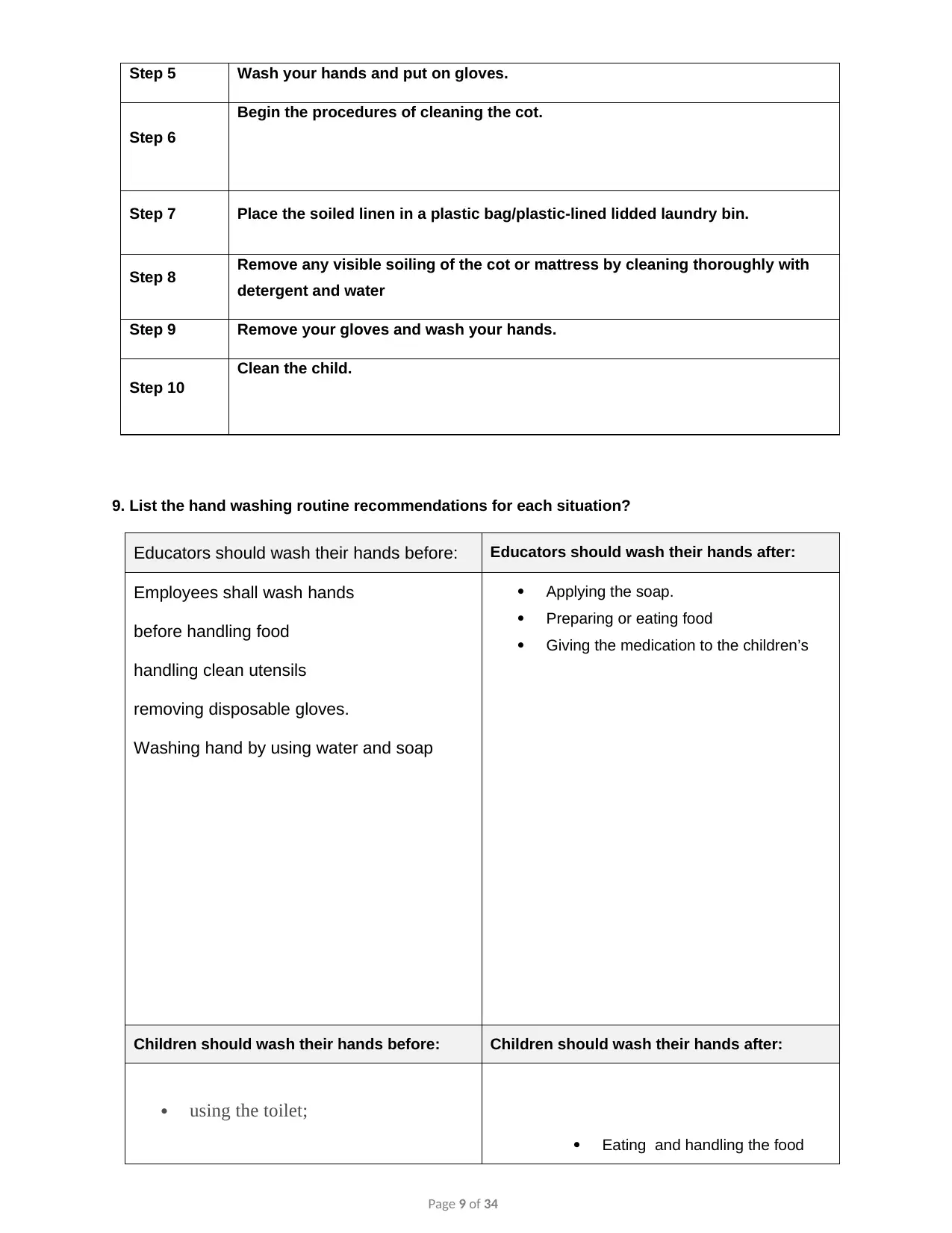
Step 5 Wash your hands and put on gloves.
Step 6
Begin the procedures of cleaning the cot.
Step 7 Place the soiled linen in a plastic bag/plastic-lined lidded laundry bin.
Step 8 Remove any visible soiling of the cot or mattress by cleaning thoroughly with
detergent and water
Step 9 Remove your gloves and wash your hands.
Step 10
Clean the child.
9. List the hand washing routine recommendations for each situation?
Educators should wash their hands before: Educators should wash their hands after:
Employees shall wash hands
before handling food
handling clean utensils
removing disposable gloves.
Washing hand by using water and soap
Applying the soap.
Preparing or eating food
Giving the medication to the children’s
Children should wash their hands before: Children should wash their hands after:
using the toilet;
Eating and handling the food
Page 9 of 34
Step 6
Begin the procedures of cleaning the cot.
Step 7 Place the soiled linen in a plastic bag/plastic-lined lidded laundry bin.
Step 8 Remove any visible soiling of the cot or mattress by cleaning thoroughly with
detergent and water
Step 9 Remove your gloves and wash your hands.
Step 10
Clean the child.
9. List the hand washing routine recommendations for each situation?
Educators should wash their hands before: Educators should wash their hands after:
Employees shall wash hands
before handling food
handling clean utensils
removing disposable gloves.
Washing hand by using water and soap
Applying the soap.
Preparing or eating food
Giving the medication to the children’s
Children should wash their hands before: Children should wash their hands after:
using the toilet;
Eating and handling the food
Page 9 of 34
⊘ This is a preview!⊘
Do you want full access?
Subscribe today to unlock all pages.

Trusted by 1+ million students worldwide
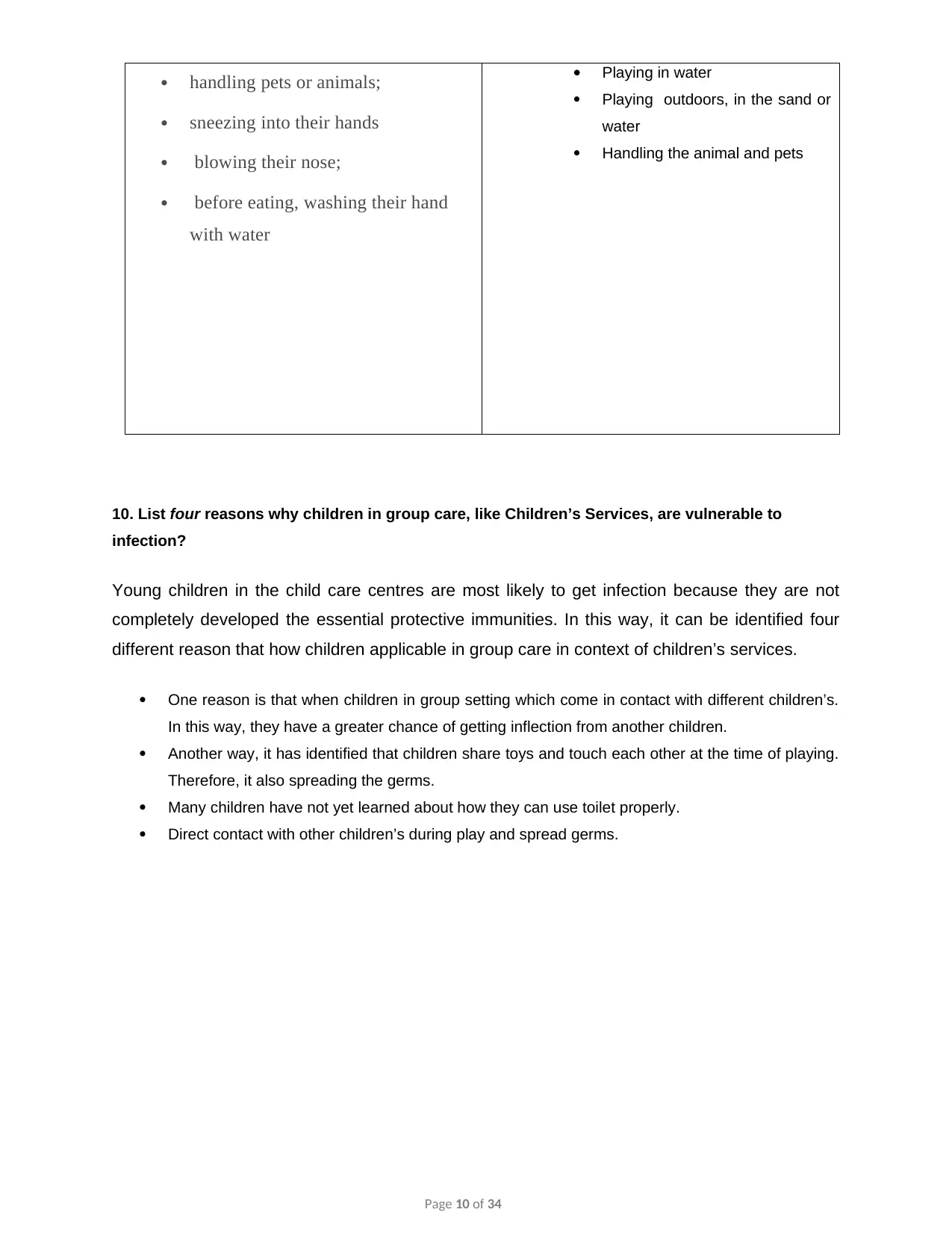
handling pets or animals;
sneezing into their hands
blowing their nose;
before eating, washing their hand
with water
Playing in water
Playing outdoors, in the sand or
water
Handling the animal and pets
10. List four reasons why children in group care, like Children’s Services, are vulnerable to
infection?
Young children in the child care centres are most likely to get infection because they are not
completely developed the essential protective immunities. In this way, it can be identified four
different reason that how children applicable in group care in context of children’s services.
One reason is that when children in group setting which come in contact with different children’s.
In this way, they have a greater chance of getting inflection from another children.
Another way, it has identified that children share toys and touch each other at the time of playing.
Therefore, it also spreading the germs.
Many children have not yet learned about how they can use toilet properly.
Direct contact with other children’s during play and spread germs.
Page 10 of 34
sneezing into their hands
blowing their nose;
before eating, washing their hand
with water
Playing in water
Playing outdoors, in the sand or
water
Handling the animal and pets
10. List four reasons why children in group care, like Children’s Services, are vulnerable to
infection?
Young children in the child care centres are most likely to get infection because they are not
completely developed the essential protective immunities. In this way, it can be identified four
different reason that how children applicable in group care in context of children’s services.
One reason is that when children in group setting which come in contact with different children’s.
In this way, they have a greater chance of getting inflection from another children.
Another way, it has identified that children share toys and touch each other at the time of playing.
Therefore, it also spreading the germs.
Many children have not yet learned about how they can use toilet properly.
Direct contact with other children’s during play and spread germs.
Page 10 of 34
Paraphrase This Document
Need a fresh take? Get an instant paraphrase of this document with our AI Paraphraser
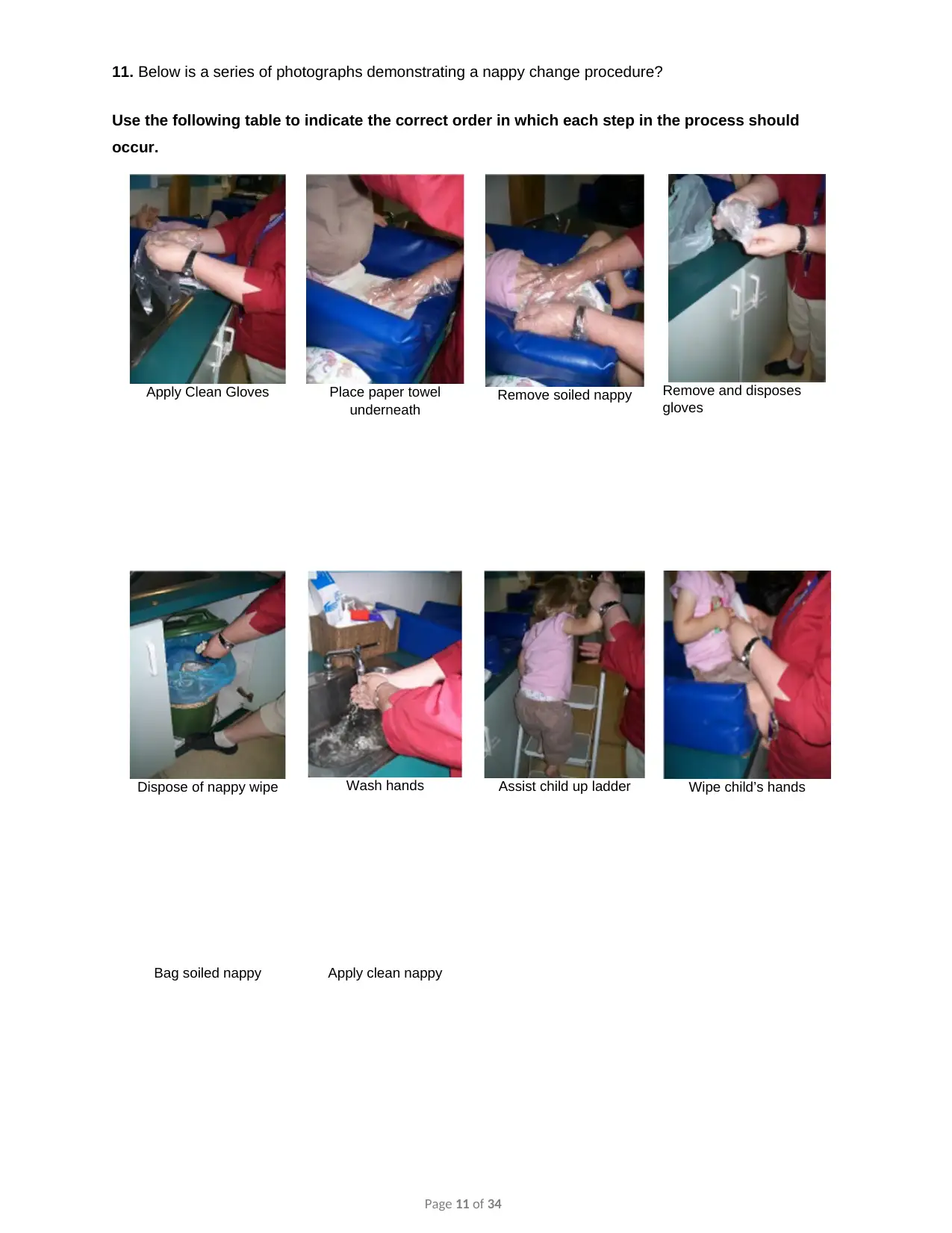
11. Below is a series of photographs demonstrating a nappy change procedure?
Use the following table to indicate the correct order in which each step in the process should
occur.
Apply Clean Gloves Place paper towel
underneath
Remove soiled nappy Remove and disposes
gloves
Dispose of nappy wipe Wash hands Assist child up ladder Wipe child’s hands
Bag soiled nappy Apply clean nappy
Page 11 of 34
Use the following table to indicate the correct order in which each step in the process should
occur.
Apply Clean Gloves Place paper towel
underneath
Remove soiled nappy Remove and disposes
gloves
Dispose of nappy wipe Wash hands Assist child up ladder Wipe child’s hands
Bag soiled nappy Apply clean nappy
Page 11 of 34
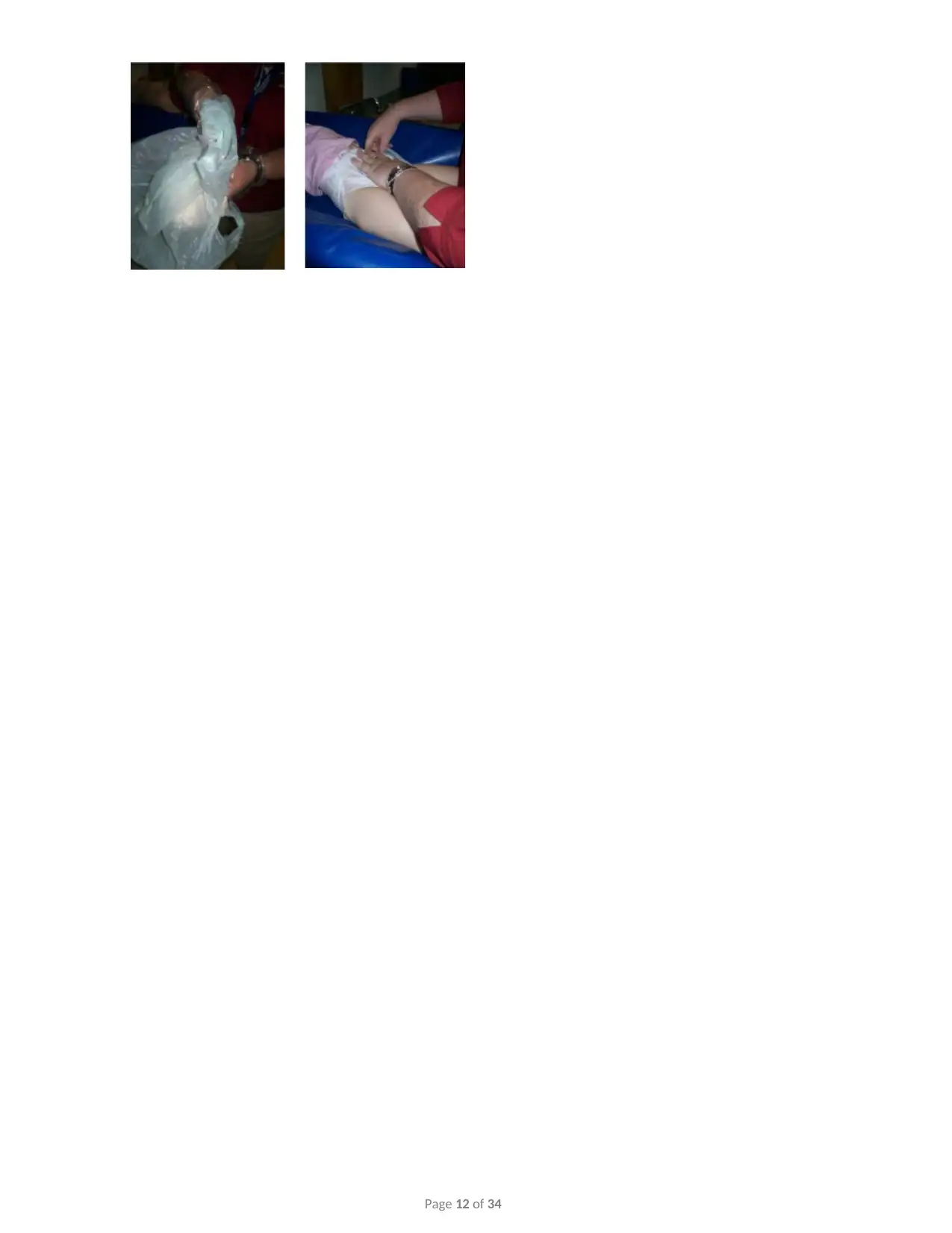
Page 12 of 34
⊘ This is a preview!⊘
Do you want full access?
Subscribe today to unlock all pages.

Trusted by 1+ million students worldwide
1 out of 34
Related Documents
Your All-in-One AI-Powered Toolkit for Academic Success.
+13062052269
info@desklib.com
Available 24*7 on WhatsApp / Email
![[object Object]](/_next/static/media/star-bottom.7253800d.svg)
Unlock your academic potential
Copyright © 2020–2025 A2Z Services. All Rights Reserved. Developed and managed by ZUCOL.





